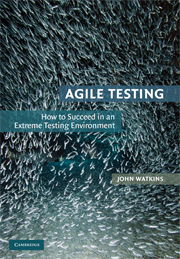Book contents
- Frontmatter
- Contents
- Foreword by Bob Bartlett
- Acknowledgments
- 1 Introduction
- PART 1 REVIEW OF OLD-SCHOOL AND AGILE APPROACHES
- PART 2 EVERYONE IS DIFFERENT: AGILE CASE STUDIES
- PART 3 AGILE MY WAY: A PROPOSAL FOR YOUR OWN AGILE TEST PROCESS
- APPENDIX A The Principles of Rapid Application Development
- APPENDIX B The Rules and Practices of Extreme Programming
- Appendix C The Principles of the Dynamic Systems Development Method
- Appendix D The Practices of Scrum
- APPENDIX E Agile Test Script Template
- Appendix F Agile Test Result Record Form Template
- Appendix G Agile Test Summary Report Template
- Appendix H My Agile Process Checklist
- References
- Index
APPENDIX A - The Principles of Rapid Application Development
Published online by Cambridge University Press: 26 October 2009
- Frontmatter
- Contents
- Foreword by Bob Bartlett
- Acknowledgments
- 1 Introduction
- PART 1 REVIEW OF OLD-SCHOOL AND AGILE APPROACHES
- PART 2 EVERYONE IS DIFFERENT: AGILE CASE STUDIES
- PART 3 AGILE MY WAY: A PROPOSAL FOR YOUR OWN AGILE TEST PROCESS
- APPENDIX A The Principles of Rapid Application Development
- APPENDIX B The Rules and Practices of Extreme Programming
- Appendix C The Principles of the Dynamic Systems Development Method
- Appendix D The Practices of Scrum
- APPENDIX E Agile Test Script Template
- Appendix F Agile Test Result Record Form Template
- Appendix G Agile Test Summary Report Template
- Appendix H My Agile Process Checklist
- References
- Index
Summary
In certain situations, a usable 80% solution can be produced in 20% of the time that would have been required to produce a total solution.
Walter ManerIntroduction
This appendix reviews the essential rules and practices of the Rapid Application Development (RAD) agile method, focusing in more detail on the testing aspects of the method.
The guiding principles of RAD are to deliver usable high-quality systems quickly and with low costs. The RAD rules and practices are discussed under the following sections:
Overview of the Characteristics of RAD Projects,
Joint Application Design,
Rapidity of Development, and
Incremental Prototyping.
Overview of the Characteristics of RAD Projects
RAD seeks to avoid the traditional problems associated with large, monolithic waterfall-style projects by breaking the organization and management of the project tasks into smaller, more easily managed increments.
Historically, RAD projects have been most successful when employed to develop relatively small and simple applications, with low complexity and risk. For larger, more complex applications, such as the implementation of a company-wide customer relationship management (CRM) system, for example, organizations typically looked to more mature software project management and development approaches (such as PRINCE [22]). A number of organizations have had success combining both approaches, with PRINCE used for the overall management of the project and RAD employed to develop the comparatively simple and low-complexity applications that run against (using our preceding example) the CRM system.
- Type
- Chapter
- Information
- Agile TestingHow to Succeed in an Extreme Testing Environment, pp. 259 - 262Publisher: Cambridge University PressPrint publication year: 2009



